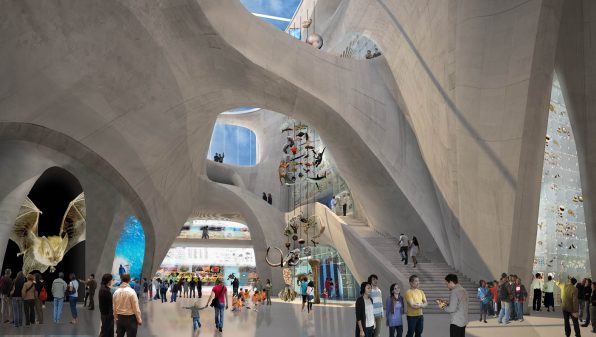New York Times — “Natural History Museum’s Expansion: Part Dr. Seuss, Part Jurassic Park”
November 5, 2015
“The American Museum of Natural History recently came out with some good news—a museum expansion that for once seems as if it could work.
A year ago, the museum announced plans for the $325 million, 218,000-square-foot Richard Gilder Center for Science, Education and Innovation. Jeanne Gang, founder of Studio Gang, the high-profile Chicago-based firm, won a competition to design it. She teamed with Reed Hilderbrand, the landscape architects from Cambridge, Mass. …
Well, now we know more or less what the actual project looks like. It bids to be the city’s next architectural spectacle.
The museum’s trustees approved a conceptual design on Wednesday and released drawings and renderings. The project promises much more room for education, exhibitions, laboratories, the library, open storage and a live butterfly conservatory. It includes a new theater devoted to invisible worlds—meaning microscopic creatures, the human brain, the ocean depths and the edge of the universe. The proposed center also solves humdrum but critical layout problems, integrating dead-end galleries and bringing public spaces, classrooms and research together in a single, soaring, canyonlike, central hall, behind an undulating stone-and-glass facade.
That’s the big move. With reinforced-concrete arches and balconies shaped like immense rocky outcroppings or glacial formations, the hall vies with the Theodore Roosevelt Rotunda, the museum’s towering entrance on the opposite side of the campus. It’s part Dr. Seuss, part Jurassic Park, part parametric extravaganza, adding a kind of naturalism to abstract, airborne forms associated with contemporary architecture at its most theatrical. …
And there’s function to the form. This is a museum in the business of wonderment and awe. A half-million schoolchildren visit each year. The institution trains thousands of teachers. It dispenses advanced degrees in science education and comparative biology. Ellen V. Futter, the president of the museum, talks about an urgent need to kindle children’s curiosity and develop a more science-literate public. This is not spin. An informed electorate and healthier environment depend on broadening public understanding of science, engineering and technology.
What the center doesn’t do is occupy nearly as much parkland as critics feared. Mindful of neighborhood concerns, the museum clearly pulled the project back as much as possible from the park, consolidating on its existing footprint by knocking down three of its own buildings, claiming only 11,600 square feet, or a quarter acre, of parkland.”
